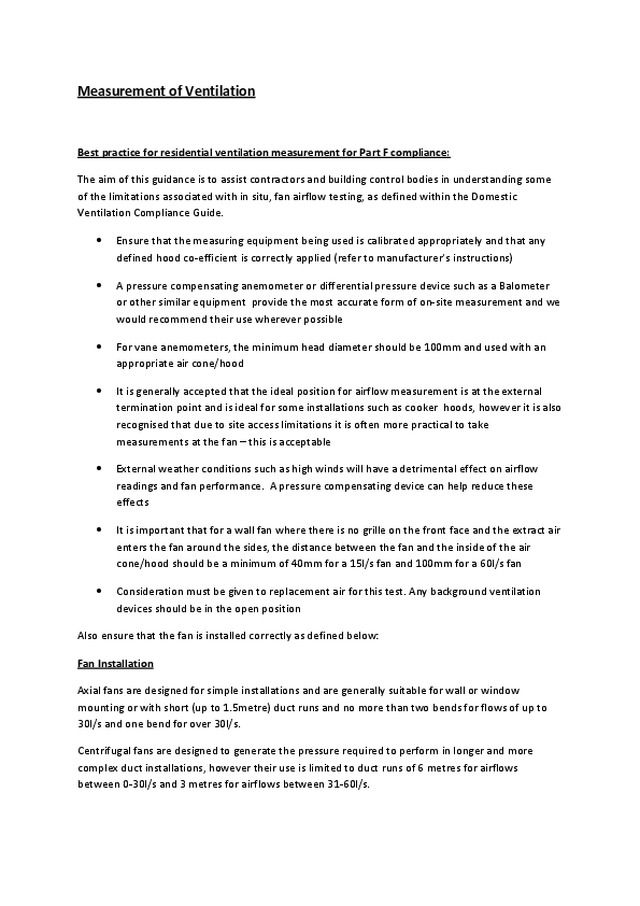Shopping Cart
0 points
Distributor Selection
Select the distributor you would like to use for your shopping cart.
Distributor


Vent-Axia - Best residential ventilation measurement practice for Part F compliance
Measurement of Ventilation Best practice for residential ventilation measurement for Part F compliance: The aim of this guidance is to assist contractors and building control bodies in understanding some of the limitations associated with in situ, fan airflow testing, as defined within the Domestic Ventilation Compliance Guide. Ensure that the measuring equipment being used is calibrated appropriately and that any defined hood co-efficient is correctly applied (refer to manufacturer’s instructions) A pressure compensating anemometer or differential pressure device such as a Balometer or other similar equipment provide the most accurate form of on-site measurement and we would recommend their use wherever possible For vane anemometers, the minimum head diameter should be 100mm and used with an appropriate air cone/hood It is generally accepted that the ideal position for airflow measurement is at the external termination point and is ideal for some installations such as cooker hoods, however it is also recognised that due to site access limitations it is often more practical to take measurements at the fan – this is acceptable External weather conditions such as high winds will have a detrimental effect on airflow readings and fan performance. A pressure compensating device can help reduce these effects It is important that for a wall fan where there is no grille on the front face and the extract air enters the fan around the sides, the distance between the fan and the inside of the air cone/hood should be a minimum of 40mm for a 15l/s fan and 100mm for a 60l/s fan Consideration must be given to replacement air for this test. Any background ventilation devices should be in the open position Also ensure that the fan is installed correctly as defined below: Fan Installation Axial fans are designed for simple installations and are generally suitable for wall or window mounting or with short (up to 1.5metre) duct runs and no more than two bends for flows of up to 30l/s and one bend for over 30l/s. Centrifugal fans are designed to generate the pressure required to perform in longer and more complex duct installations, however their use is limited to duct runs of 6 metres for airflows between 0-30l/s and 3 metres for airflows between 31-60l/s.
To reduce risk of restricted airflow when installing fans with flexible duct, please follow the guidance below: The inner radius of any bend should be greater or equal to the diameter of the ducting being used. If the radius is reduced, the resistance of the bend will increase and the volume of air being extracted will decrease (see “Do” diagram above). Ensure flexible ducting is installed without peaks or troughs (see “Don’t” diagram above). External terminations must have at least 90% equivalent free area of the ductwork being used. Vane anemometers and performance deviations
If a vane anemometer is used on site then the installed performance of a fan is likely to be higher than indicated due to the extra resistance generated by the restriction to airflow caused by the air cone/hood and the anemometer itself. This deviation is in addition to the instrument manufacturer’s accuracy and the resistance provided by the installation and will be dependent on the type of fan being used. Airflow can be accurately calculated from the fan performance curve supplied by the manufacturer and some manufacturers may provide specific information on their fan models. However as a guide, axial fans may show a similar variance to that defined on the chart below. For example, a fan with a design extract rate of 15l/s as required by Approved Document F (a typical 100mm bathroom axial fan) the readings may be measured at 15% below the actual amount of air being extracted (i.e. measuring 12l/s). With increased airflow, the resistance of the vane anemometer and deviation of readings increases. For example, at 60l/s (a typical 150mm kitchen axial fan) readings may be measured at 40% below the actual amount of air being extracted (i.e. measuring 36 l/s). A correctly applied hood co-efficient and appropriately applied ‘deviation’ characteristic should enable more accurate application of vane anemometers. The deviation is more significant for Axial Flow fans than for Centrifugal fans. What to do if all the above fails to deliver the correct airflow of an extract fan Should the measurements on site fail to meet the required airflow, but fulfil the criteria above then the next approach is to use a more accurate measuring device or check the suitability of the fan type and the overall installation.